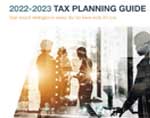Many small businesses start out as “lean enterprises,” with costs kept to a minimum to lower risks and maximize cash flow. But there comes a point in the evolution of many companies — particularly in a tight job market — when investing money in employee benefits becomes advisable, if not downright mandatory.
Is now the time for your small business to do so? More specifically, as you compete for top talent and look to retain valued employees, would launching a retirement plan help your case? Quite possibly, and the good news is the federal government is offering some intriguing incentives for eligible smaller companies ready to make the leap.
Late last year, the Consolidated Appropriations Act, 2023 was signed into law. Within this massive spending package lies the Setting Every Community Up for Retirement Enhancement 2.0 Act (SECURE 2.0). Its provisions bring three key improvements to the small employer pension plan start-up cost tax credit, beginning this year:
1. Full coverage for the smallest of small businesses. SECURE 2.0 makes the credit equal to the full amount of creditable plan start-up costs for employers with 50 or fewer employees, up to an annual cap. Previously only 50% of costs were allowed — this limit still applies to employers with 51 to 100 employees.
2. Glitch fixed for multiemployer plans. SECURE 2.0 retroactively fixes a technical glitch that prevented employers who joined multiemployer plans in existence for more than three years from claiming the small employer pension plan start-up cost credit. If your business joined a pre-existing multiemployer plan before this period, contact us about filing amended returns to claim the credit.
3. Enhancement of employer contributions. Perhaps the biggest change wrought by SECURE 2.0 is that certain employer contributions for a plan’s first five years now may qualify for the credit. The credit is increased by a percentage of employer contributions, up to a per-employee cap of $1,000, as follows:
- 100% in the plan’s first and second tax years,
- 75% in the third year,
- 50% in the fourth year, and
- 25% in the fifth year.
For employers with between 51 and 100 employees, the contribution portion of the credit is reduced by 2% times the number of employees above 50.
In addition, no employer contribution credit is allowed for contributions for employees who make more than $100,000 (adjusted for inflation after 2023). The credit for employer contributions is also unavailable for elective deferrals or contributions to defined benefit pension plans.
To be clear, though the name of the tax break is the small employer pension plan start-up cost credit, it also applies to qualified plans such as 401(k)s and SIMPLE IRAs, as well as to Simplified Employee Pensions. Our firm can help you determine whether now is indeed the right time for your small business to launch a retirement plan and, if so, which one.
© 2023




